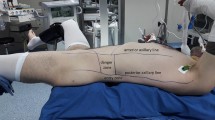Abstract
Introduction
Percutaneous nephrolithotomy (PNL) is the primary treatment modality for management of staghorn stones. PNL in supine position has important advantages over prone positon. However, studies comparing prone and supine positions for PNL in staghorn stone patients have conflicting results, and the aim of the current study was to compare prone and supine positions for PNL in staghorn stone cases.
Patients and methods
Data of patients underwent PNL for staghorn stones in supine or prone position by a single urologist were collected prospectively. The supine and prone position groups were compared for stone free rate (SFR) and complication rates. All patients were evaluated with NCCT for evaluation of SFR. Chi-square test was used to compare categorical variables and Student t test was applied for continuous variables of the treatment groups.
Results
The groups were similar for demographic and stone-related characteristics. Multi-caliceal and intercostal access was more common in prone position. Operation duration was significantly shorter and hemoglobin drop was significantly less in supine group. SFR was 64.1 and 60.4% in the supine and prone groups, respectively (p = 0.72). Complication rates were similar in the two groups but Clavien III complications were observed in two patients in the prone group.
Conclusions
PNL in supine position is an effective treatment for management of staghorn stones. The need for multi-caliceal and intercostal puncture is less when combined with retrograde intrarenal surgery. PNL in supine position should be considered as primary treatment option in staghorn stone cases.



Similar content being viewed by others
References
Turk C, Petrik A, Sarica K et al (2016) EAU guidelines on interventional treatment for urolithiasis. Eur Urol 69(3):475–482 (PubMed PMID: 26344917)
Cohen J, Cohen S, Grasso M (2013) Ureteropyeloscopic treatment of large, complex intrarenal and proximal ureteral calculi. BJU Int 111(3 Pt B):E127-31 (PubMed PMID: 22757752)
Desai M, De Lisa A, Turna B et al (2011) The clinical research office of the endourological society percutaneous nephrolithotomy global study: staghorn versus nonstaghorn stones. J Endourol 25(8):1263–1268 (PubMed PMID: 21774666)
El-Nahas AR, Elshal AM, El-Tabey NA, El-Assmy AM, Shokeir AA (2016) Percutaneous nephrolithotomy for staghorn stones: a randomised trial comparing high-power holmium laser versus ultrasonic lithotripsy. BJU Int 118(2):307–312 (PubMed PMID: 26779990)
Ghani KR, Andonian S, Bultitude M et al (2016) Percutaneous nephrolithotomy: update, trends, and future directions. Eur Urol 70(2):382–396 (PubMed PMID: 26876328)
Buldu I, Tepeler A, Karatag T, Inan R, Armagan A, Istanbulluoglu O (2016) Combined micro-and standard percutaneous nephrolithotomy for complex renal calculi. Turk J Urol 42(3):150–154 (PubMed PMID: 27635289, Pubmed Central PMCID: PMC5012441)
Ibarluzea G, Scoffone CM, Cracco CM et al (2007) Supine Valdivia and modified lithotomy position for simultaneous anterograde and retrograde endourological access. BJU Int 100(1):233–236 (PubMed PMID: 17552975)
Scoffone CM, Cracco CM, Poggio M, Scarpa RM (2010) Endoscopic combined intrarenal surgery for high burden renal stones. Arch Ital Urol Androl 82(1):41–42 (PubMed PMID: 20593718)
Cracco CM, Scoffone CM (2011) ECIRS (Endoscopic combined intrarenal surgery) in the Galdakao-modified supine Valdivia position: a new life for percutaneous surgery? World J Urol 29(6):821–827 (PubMed PMID: 22057344)
Scoffone CM, Cracco CM, Cossu M, Grande S, Poggio M, Scarpa RM (2008) Endoscopic combined intrarenal surgery in Galdakao-modified supine Valdivia position: a new standard for percutaneous nephrolithotomy? Eur Urol 54(6):1393–1403 (PubMed PMID: 18715696)
Sofer M, Giusti G, Proietti S et al (2016) Upper calyx approachability through a lower calyx access for prone versus supine percutaneous nephrolithotomy. J Urol 195(2):377–382 (PubMed PMID: 26254723)
Astroza G, Lipkin M, Neisius A et al (2013) Effect of supine vs prone position on outcomes of percutaneous nephrolithotomy in staghorn calculi: results from the Clinical Research Office of the Endourology Society Study. Urology 82(6):1240–1244 (PubMed PMID: 24063939)
Wen J, Xu G, Du C, Wang B (2016) Minimally invasive percutaneous nephrolithotomy versus endoscopic combined intrarenal surgery with flexible ureteroscope for partial staghorn calculi: a randomised controlled trial. Int J Surg 28:22–27 (PubMed PMID: 26898135)
Falahatkar S, Mokhtari G, Teimoori M (2016) An update on supine versus prone percutaneous nephrolithotomy: a meta-analysis. Urol J 13(5):2814–2822 (PubMed PMID: 27734421)
Yuan D, Liu Y, Rao H et al (2016) Supine versus prone position in percutaneous nephrolithotomy for kidney calculi: a meta-analysis. J Endourol 30(7):754–763 (PubMed PMID: 27072075)
Hamamoto S, Yasui T, Okada A et al (2015) Efficacy of endoscopic combined intrarenal surgery in the prone split-leg position for staghorn calculi. J Endourol 29(1):19–24 (PubMed PMID: 24967643)
Gokce MI, Ozden E, Suer E, Gulpinar B, Gulpinar O, Tangal S (2015) Comparison of imaging modalities for detection of residual fragments and prediction of stone related events following percutaneous nephrolitotomy. Int Braz J Urol 41(1):86–90. (PubMed PMID: 25928513, Pubmed Central PMCID: PMC4752060)
Jagtap J, Mishra S, Bhattu A, Ganpule A, Sabnis R, Desai MR (2014) Which is the preferred modality of renal access for a trainee urologist: ultrasonography or fluoroscopy? Results of a prospective randomized trial. J Endourol 28(12):1464–1469 (PubMed PMID: 25393358)
Jessen JP, Honeck P, Knoll T, Wendt-Nordahl G (2013) Percutaneous nephrolithotomy under combined sonographic/radiologic guided puncture: results of a learning curve using the modified Clavien grading system. World J Urol 31(6):1599–1603 (PubMed PMID: 23283412)
Marchini GS, Berto FC, Vicentini FC, Shan CJ, Srougi M, Mazzucchi E (2015) Preoperative planning with noncontrast computed tomography in the prone and supine position for percutaneous nephrolithotomy: a practical overview. J Endourol 29(1):6–12 (PubMed PMID: 25025863)
Author information
Authors and Affiliations
Corresponding author
Ethics declarations
Funding
This study has no source of funding.
Conflict of interest
None of the authors have any conflict of interest.
Ethical approval
All procedures performed in studies involving human participants were in accordance with the ethical standards of the institutional and/or national research committee and with the 1964 Helsinki declaration and its later amendments or comparable ethical standards.
Informed consent
Informed consent was obtained from all individual participants included in the study.
Rights and permissions
About this article
Cite this article
Gökce, M.İ., Ibiş, A., Sancı, A. et al. Comparison of supine and prone positions for percutaneous nephrolithotomy in treatment of staghorn stones. Urolithiasis 45, 603–608 (2017). https://doi.org/10.1007/s00240-017-0977-y
Received:
Accepted:
Published:
Issue Date:
DOI: https://doi.org/10.1007/s00240-017-0977-y




